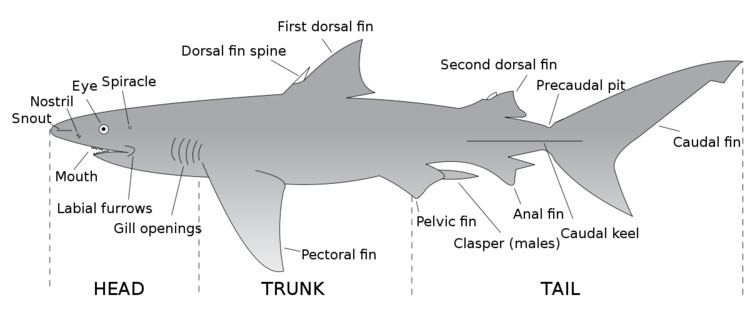 | ||
Shark anatomy has points of difference with the anatomy of bony and other types of fish. The large number of species and the diversity of shark habitats means that there are also variations on the "typical" shark's bodies.
Contents
Skeleton
The skeleton of a shark is mainly made of cartilage.
Fins
Most sharks have eight fins: a pair of pectoral fins, a pair of pelvic fins, two dorsal fins, an anal fin, and a caudal fin. The members of the order Hexanchiformes have only a single dorsal fin. The anal fin is absent in the orders Hexanchiformes, Squaliformes, Squatiniformes, and Pristiophoriformes. Shark fins are supported by internal rays called ceratotrichia.
Tail
The tail of a shark consists of the caudal peduncle and the caudal fin, which provide the main source of thrust for the shark. Most sharks have heterocercal caudal fins, meaning that the backbone extends into the (usually longer) upper lobe. The shape of the caudal fin reflects the shark's lifestyle, and can be broadly divided into five categories:
Integument
Unlike bony fish, the sharks have a complex dermal corset made of flexible collagenous fibres and arranged as a helical network surrounding their body. This works as an outer skeleton, providing attachment for their swimming muscles and thus saving energy. A similar arrangement of collagen fibres has been discovered in dolphins and squid. Their dermal teeth give them hydrodynamic advantages as they reduce turbulence while swimming.
Circulatory system
Like higher up vertebrates, sharks have a four chambered heart. Unlike other vertebrates, sharks have a single-circuit circulatory system, blood flows from the heart, to the gills where it is oxygenated, throughout the body where it is deoxygenated and then back to the heart to repeat. The flow of the heart in order is: sinus venosus, atrium, ventricle and conus arteriosus.
Respiratory system
Like other fishes, sharks extract oxygen from water as it passes over their gills. The water enters through the mouth, passes into the pharynx, and exits through the gill slits (most sharks have five pairs, the frilled sharks, cow sharks, and sixgill sawshark have six or seven pairs). Most sharks also have an accessory respiratory opening called a spiracle behind their eyes. In bottom-dwelling sharks such as angel sharks, the spiracle allows them to take in water to breathe without having to open their mouths.
There are two mechanisms that sharks can use to move water over their gills: in buccal pumping, the shark actively pulls in water using its buccal muscles, while in ram ventilation, the shark swims forward, forcing water into its mouth and through its gills. As buccal pumping is more energy-intensive than ram ventilation, the former is generally used by sedentary, bottom-dwelling sharks while the latter is used by more active sharks. Most sharks can switch between these mechanisms as the situation requires. A few species, such as the great white shark, have lost the ability to perform buccal pumping and thus will suffocate if they stop moving forward.
